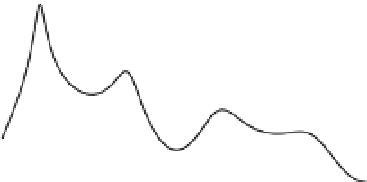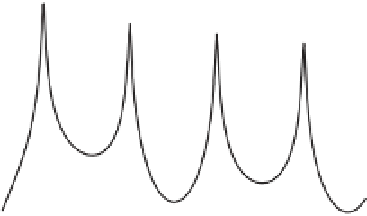Geoscience Reference
In-Depth Information
et al., 2007, for the Uvalde heavy oil) to demonstrate our
analytical approach. The normalized probability distribu-
tion function for the relaxation time of a Cole
Maxwell luid
~
1-
iωτ
m
1
ξ
(
ω
)
=
1-
~
2
J
0
(
KR
)
-
Cole dis-
K
10
3
ξ
(
ω
)
iωρ
f
2
K
=
(
1-
iωτ
m
)
tribution is given by (Cole & Cole, 1941)
η
f
=
1
2
sin
π
c
−
1
f
τ
,
2 11
π
cosh
c
ln
τ τ
m
−
cos
π
c
−
1
10
2
where 0
Cole exponent (
c
= 1 cor-
responds to an ideal Maxwell fluid). The Cole
≤
c
≤
1 is called the Cole
-
Cole distri-
bution is symmetric with respect to the characteristic
time
-
10
1
η
f
m
, which corresponds to the peak of the distri-
bution. For 0 5
τ
=
τ
Cole distribution of relax-
ation times looks like a lognormal distribution. The tail of
the Cole
≤
c
≤
1, the Cole
-
G
f
Cole distribution is however increasingly broad as
c
decreases. A comparison between theMaxwell and Cole
-
10
0
1.2
0
0.2
0.4
0.6
0.8
1
-
Cole behavior of the resonances of a generalized Maxwell
fluid is shown in Figure 2.1. In this figure, we compare
experimental data from Castrejon-Pita et al. (2003) for a
Maxwell fluid (a mixture of cetylpyridinium chloride
and sodium salicylate in a capillary) with a model in which
the Cole
ωτ
(a)
~
ξ
(
ω
)
10
3
Generalised Maxwell luid
iωτ
m
)
c
~
1-(
1
ξ
(
ω
)
=
1-
J
0
(
KR
)
2
K
iωρ
f
2
=
iωτ
m
)
c
K
1
-
(
1-
η
f
10
2
Cole distribution of relaxation times is used. An
extended Maxwell fluid with a Cole
-
Cole distribution of
relaxation times is able to represent the hydrodynamic
behavior of the fluid, while a simple Maxwell fluid (with
a single relaxation time) cannot perform that task.
The behavior of the Maxwell fluid can be considered
from the standpoint of the behavior of an equivalent
Newtonian viscous fluid with frequency-dependent bulk
modulus and dynamic shear viscosity:
-
10
1
10
0
0
0.2
0.4
0.6
0.8
1
1.2
ωτ
(b)
v
T
f
=
K
f
ω
∇
u
f
I
+2
η
f
ω
d
f
Figure 2.1
Hydrodynamic response of a viscoelastic fluid in a
linear capillary of radius
R
= 2.5 cm subject to harmonic fluid
pressure variations. The fluid is a mixture of cetylpyridinium
chloride and sodium salicylate (CPyCl/NaSal 60:100) (data from
Castrejon-Pita et al
.
, 2003). The experimental data are scaled
with respect to the viscous relaxation time
2 12
ωτ
m
c
i
e
,
−
m
c
K
f
∇
u
f
I
+2
G
f
d
f
1
−
i
ωτ
K
f
K
f
ω
=
R
2
=
ω ω
m
c
,
2 13
τ
ρ
f
η
f
(
η
f
=60Pas,
1
−
i
ρ
f
= 1050kgm
−
3
). The parameter
denotes the normalized
conductance (relative to the DC value) and
J
0
is the Bessel
function.
a)
Comparison between the experimental data and the
response predicted by a linear Maxwell fluid (
ξ
K
f
ω
∇
u
f
=
−
p
f
,
2 14
m
=19s).
b)
Comparison between the experimental data and the response
predicted by a generalized Maxwell fluid using a Cole
τ
p
f
p
f
ω
=
ω ω
m
c
,
2 15
1
−
i
-
Cole
distribution of relaxation times (
τ
m
=29s, Cole
-
Cole exponent
η
f
η
f
ω
=
2 16
c
= 0.9, parameters optimized with a Newton
Raphson
minimization method using the L
2
norm).
J
0
denotes the Bessel
function of zero order.
-
ω ω
m
c
1
−
i
Using the Boussinesq approximation, the flow of a
fluid inside a deformable porous material is governed
locally by the Navier
Stokes equation, which acts as a
momentum conservation equation:
-
ρ
f
∂
v
f
∂
=
−∇
p
f
+
∇
π
+
F
f
,
2 17
t





















































































































































































































































































